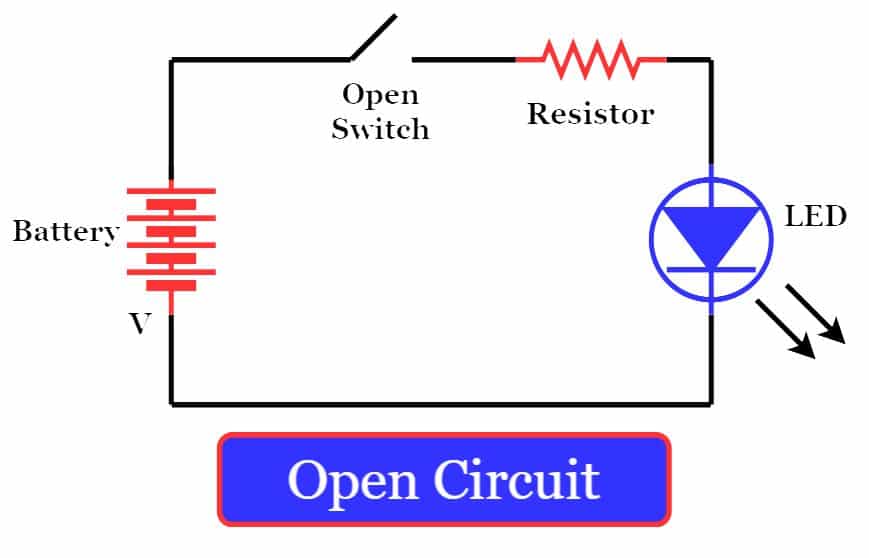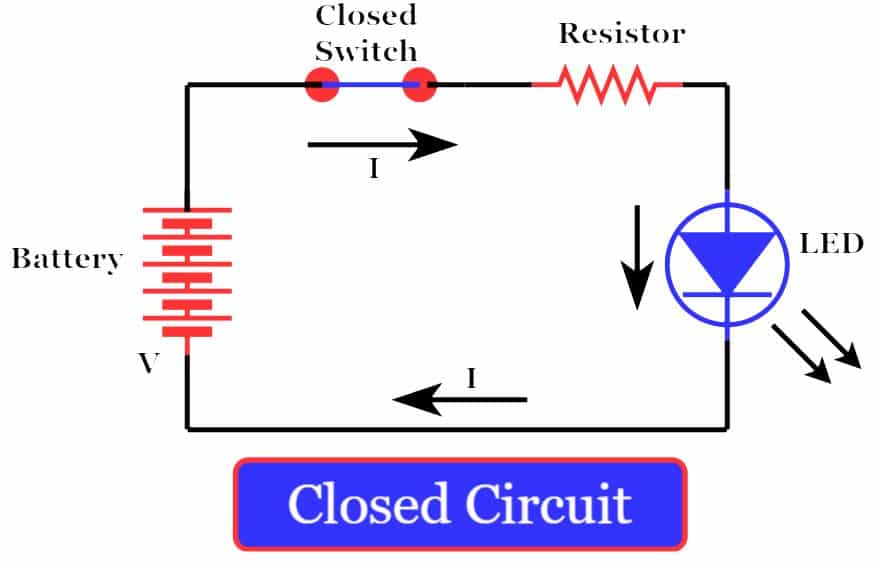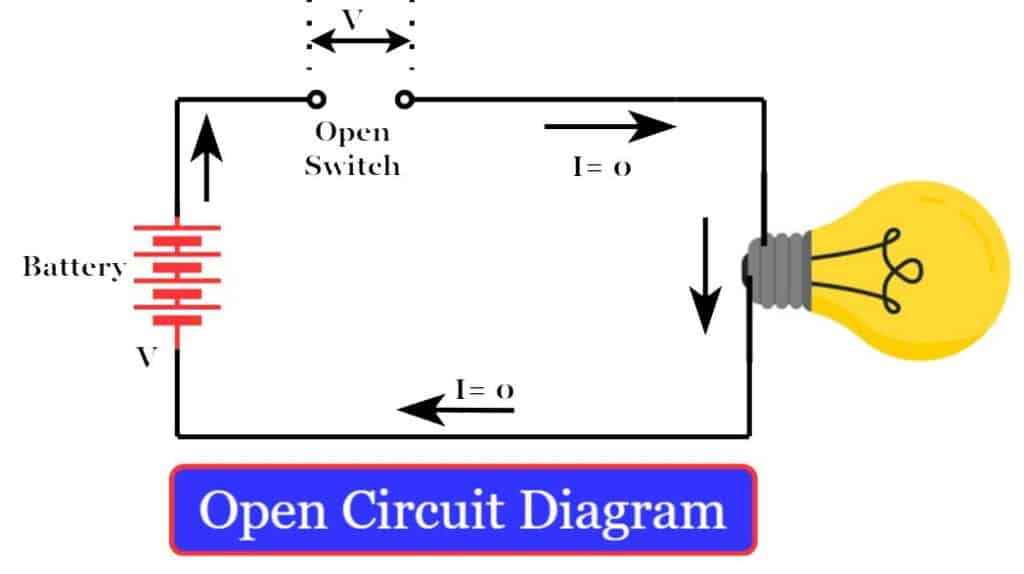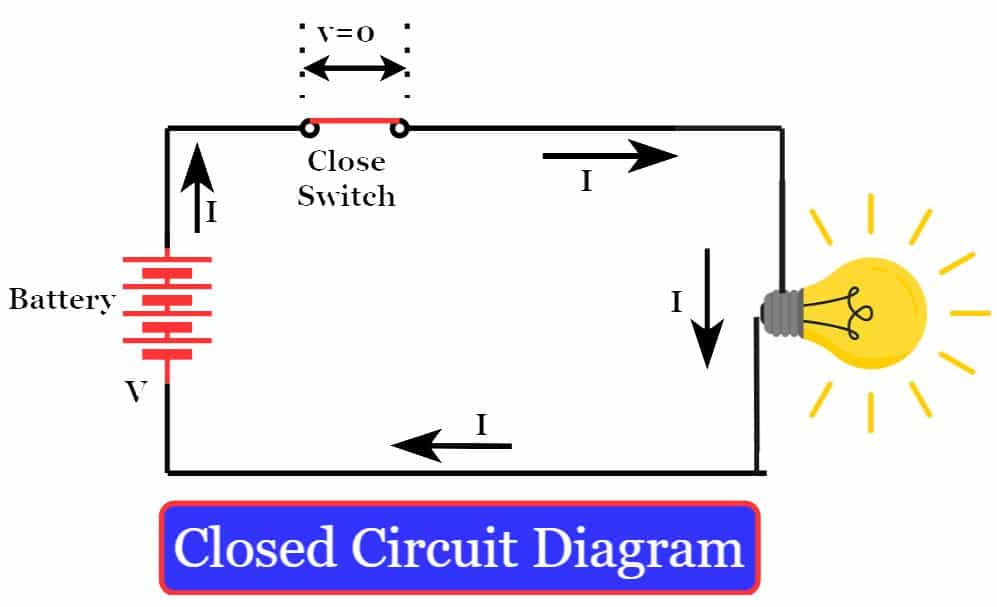The main difference between the open circuit and a closed circuit is that electric current can not flow in an open circuit, whereas the electric current flows in a closed circuit.
Before understanding other differences, let us first discuss what an open circuit and a closed circuit are.
What is Open Circuit?
When the electric circuit path breaks or opens, the flow of electrons or current through the path interrupts. Thus, an incomplete electric circuit path causes an open circuit.
In two conditions. the open circuit happens.
- When the equipment is switched off by an on/off switch
- When safety devices like fuse blow during fault and open the circuit
Example of Open Circuit:
A light emitting diode(LED) is connected to the DC supply source. The circuit has a series of connections of LED, on/off switch, and current limiting resistor(R).

The electric current does not flow from the supply source to LED when the switch is open. Hence, LED remains off in this condition.
The potential difference across the open circuit terminals becomes equal to the supply voltage and the space between the open circuit acts as an insulator. Therefore, the resistance of the open circuit is infinite.
What is Closed Circuit?
A closed circuit makes a closed-loop path, and current flows from the supply source to load. Thus, a closed circuit has a supply source, conductor, and load, and these circuit components form a closed-loop path.
Example of Closed Circuit
A LED is connected to a voltage source as shown below figure. On closing the switch, the current flow through the LED and it glows because the electric circuit forms a closed loop.

The voltage drop across closing contacts of the switch is almost zero when current flows through the circuit. The zero voltage drop between the contacts is not possible because contact points have a certain contact resistance.
Open and Closed Circuit Diagram
Open Circuit: There is no electrical connection between the supply source and the load.

Any break in the electric circuit causes an open circuit and no current flows in the circuit.
Closed Circuit: In a closed circuit, the circuit is complete and forms a closed loop. Therefore, the current flow from the supply source to the load.

For small rating electrical equipment, we use a switch to make on and then off the equipment. The switch makes and breaks the electrical circuit. When the switch is in its off position, the circuit gets open circuited. On changing the position of the switch from its off position to on position, the switch contacts close the electrical circuit.
For handling a large current in the power system, we use a circuit breaker to on and off the electrical circuit. The circuit breaker also opens the circuit during a fault condition. The fuses also open the circuit during fault.
Difference between Open Circuit and Close Circuit
The differences between the open circuit and closed circuit (Open circuit vs Closed circuit) are given in the below table.
| Content | Open Circuit | Closed circuit |
| Basic | An open circuit breaks the path of an electrical circuit and causes an interruption of the flow of active energy from the supply source to the load | The closed path makes the electric circuit complete and leads to the flow of active energy from the source to the load. |
| Electric Current | The current can not flow in an open circuit. | The current flows in a closed circuit. |
| Potential Difference | The potential difference across the breaking points of the circuit is equal to the supply voltage. | The potential difference across the closing contact of the circuit is almost zero. |
| Symbol | The symbol of an open circuit is represented by ‘( )’. | The symbol of a closed circuit is represented by ‘( . )‘, |
| Nature | It does not allow the transfer of electrons or current from the supply source to the load. Thus, it does not transfer electrical energy. | The closed circuit transfers electrical energy from the supply source to the load. |
| State | An open circuit remains in the OFF state. | A closed circuit remains in the ON state. |